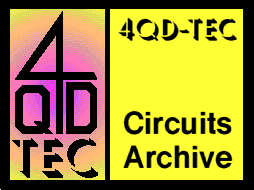

|
4QD-TEC
|
|
Electricity seems very difficult for most people to understand. You can't properly see it, you can't properly feel it and you can't taste it or smell it so what is it? It travels quite well through metals and generally poorly through non-metals. It doesn't behave quite like anything else.
But this is not quite true: fluid flowing through a system of pipes can behave in many respects like electricity flowing in a circuit. The 'obvious' exception to this is that if you pierce a pipe full of water, the water comes out.
Try piercing the insulation and touching the conductor: you will soon find the electricity coming out! The main difference is that water will fill any space whereas electricity will 'fill' only a conductor. Yes - the analogy is not perfect, but it is helpful and understanding will come not only from the similarities but also from the differences.
In the water system resistance doesn't equate to anything useful as an aid to understanding. However 'resistance' is just that: the amount that the pipe 'resists' the flow of water. Double the water pressure and the flow will double. Double the length of the pipe and, if we didn't change the pressure, we would expect the flow to halve. This, in common sense terms, is exactly what Ohm's law says! Increase the pressure and the flow must increase. Increase the resistance and the flow must decrease. So Ohm's law is Pressure/Resistance = flow. Or Volts/Ohms = amps.
Do you see then that capacitance in an electrical circuit equates to the base area of the water tank. Capacitance equates to square feet. In a water (electrical) system, volume (coulombs) is base area (capacitance) times feet head (voltage). In a capacitor, 1 coulomb stored in a 1 Farad capacitor raises the pressure to 1 volt. In a water system 1 cubic foot stored in a tank of base area 1 square foot raises the pressure to 1 foot. The analogy is quite close! Consider also that in electricity, the capacitance between two plates is directly proportional to their area so you might expect area and capacitance to be related.
I find the analogy of little use here - because water is so heavy you really cannot envisage it changing direction and doing anything useful! For a.c. in a water system you have to think of waves on an ocean! Even that is interesting, since if you think of the pressure a few feet below the surface, it will have a steady (d.c.) level with a superimposed a.c. level due to the waves: this is exactly what happens in most electronic circuits: the a.c. level is superimposed on a steady d.c. level!
But consider a water tank (capacitor). To get pressure we have to fill the tank (current must flow) for some time to establish a head of pressure (voltage) - so current must flow into the capacitor before we can get voltage across it...
Consider a mass - an inductor. You have to push a mass (pressure, voltage across an inductor) quite hard before it starts to move (current starts to flow). So in an inductor, voltage (pressure) across the inductor comes first, current through it follows! Via the analogy, understanding is quite easy.
And Yes: I know there are Mnemonics for remembering this. Any emails about Eli the ice man will be binned! Mnemonics do not help you understand! Understanding is not the same as remembering. Mnemonics help you remember only!
If you want more reading on this analogy try
http://www.paranoia.com/~filipg/HTML/REPAIR/.
The author has not tested these links.
For more information about colour codes and notations such as 3n3, check out our own page Resistors and capacitors
| 4QD Sites: |